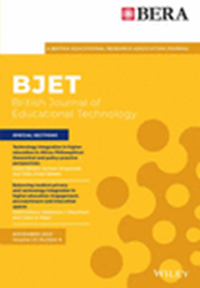Evaluating how extended reality delivery device and preservice teacher major impact presence in immersive learning environments
Abstract
Teacher education has begun to embrace the use of 360 videos to improve preservice teachers' (PSTs) engagement and immersion. While recent research on such use is promising overall, there are specific questions that have been left unanswered about the construct of presence in 360 videos. More specifically, research has yet to fully explore how video delivery devices and PST characteristics may impact presence. The purpose of this study was to respond to this gap in the literature by examining PST major, delivery device (ie, head mounted display vs. flat screen), and the interaction between the two in informing presence. A total of 93 PSTs watched 360 videos and then completed a questionnaire. Findings indicated that presence in head-mounted displays was related to emotions and agency. Conversely, presence with flat screens meant familiarity and control. Moreover, PST major was a predictor of presence, suggesting that 360 videos should be personalized according to PST career and professional goals. Finally, the interaction effect of preparing to teach K-12 mathematics and wearing a head-mounted display had a negative and statistically significant effect on participants' perceived presence, thus indicating a non-cumulative effect.
Practitioner notes
What is already known about this topic
- 360 videos are increasingly used to support preservice teacher training.
- 360 videos for teacher education foster immersion, presence, and noticing skills.
What this paper adds
- Empirical evidence that 360 videos experienced with head-mounted display facilitate agency and emotional involvement.
- Empirical evidence that 360 videos experienced with flat screens facilitate feelings of control.
- Data showed that preservice teachers' content area (math) was a positive predictor of presence in 360 videos.
Implications for practice and/or policy
- Head-mounted displays show promise as a delivery mode for 360 videos in teacher education.
- 360 videos should be personalized according to PST career and professional goals.
- The eXtended Reality Presence Scale is confirmed as a robust instrument to measure presence in immersive environments.
- More research is needed to evaluate the scalability of this approach in other contexts.

 求助内容:
求助内容: 应助结果提醒方式:
应助结果提醒方式:


